
The Ocean Accountability Board: a new model for Global Governance
Our current ways of governing our oceans is failing. What could a radically new global governance set of institutions look like that harness the power of exponential organizations?
The challenges facing governance of the ocean epitomize the challenges facing long term governance of all facets of the international system, whether these be in international trade & industry; long term investment and economic development; employment, skills and human capital; internet governance; agriculture and food security; environment and resources sustainability.
The global architecture of governance is being redrawn by new forces. These include the impact of internet connectivity, social media, rising expectations of citizens, growing consumer pressure, and will continue to be disrupted as new forces emerge, whether these be from greater demographic pressures, more volatile climate conditions, new technologies such as Artificial Intelligence and Machine to Machine technologies, as well as ever greater pressure toward more short term, almost instantaneous decision-making.
Many of the current governance bodies have not kept pace with the range of tools at their disposal, nor have they effectively engaged with additional stakeholders in new ways (e.g., mass media to influence public behavior rather than traditional tax and legal levers of states and court systems).
Redrawing a new governance system on a blank canvas, and equipping such a system with tools relevant today (e.g., around citizen behavior change) is neither feasible nor would such an approach ever be future-proof from the new and uncertain disruptive trends that society is likely to continue facing (e.g., via new technologies).
Could a new form of governance centered around an Ocean Accountability Board (OAB) help the world address its global commons? This article lays out the challenges facing the global ocean (which is comparable to many areas of the international system) and describes the main features of the OAB.
Our Ocean Matters
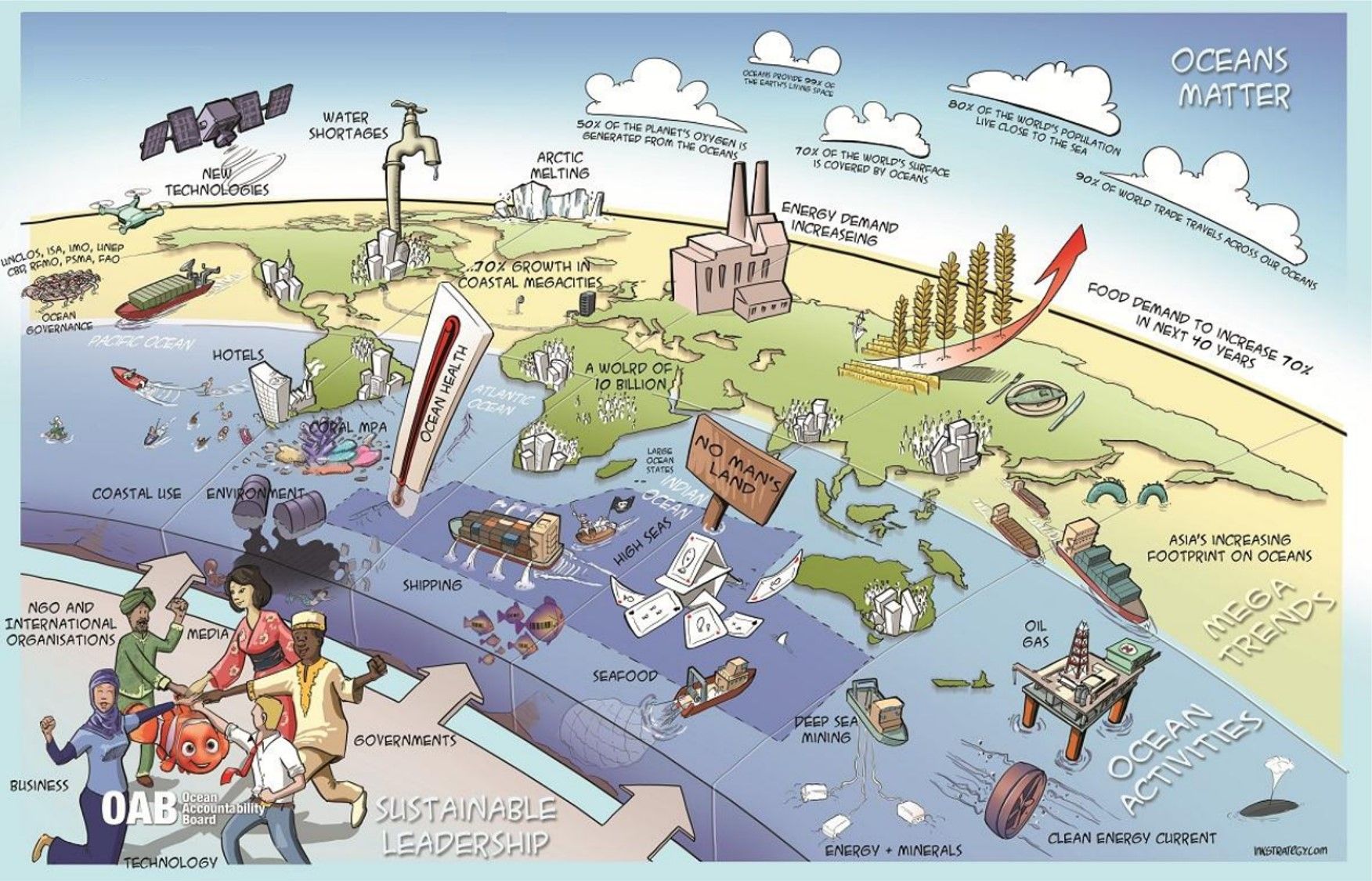
Our seas cover 70% of the world's surface2 . They generate over half the oxygen we breathe3 . Over 80% of the world's population will soon live close to the sea, and over 90% of world trade travels over the ocean4 . Over 90% of internet traffic travel via underwater cables under the high seas in areas that are not regulated by any legal body, and our ocean comprises over 99% of the earth's living space. A healthy ocean is critical not just to sustain the environment, but also to maintain the lifestyles we are used to. And yet over 90% of our ocean remains unexplored.
Mega-trends disrupting our ocean
A 'business as usual' approach to ocean governance coupled with existing and emerging activities on our seas and will not be sufficient to address some of the mega-trends that will radically alter the use of our ocean over the next century. As we move to a world of 10 billion by 20405 with 3 billion additional middle class households6 , we need to increase food production by 70% over the next 40 years, provide fresh water to urban centers in an increasingly water-stressed world, generate clean sources of energy, and ensure the continuing freedom of movement of goods and services around the world. At the same time, our activities have caused systematic changes within our environment (e.g., collapse of 80% of global fish stock, ocean deadzones around river estuaries where no marine species currently live, growing acidification of the ocean with uncertain impacts on mankind).
The current system of global ocean governance is broken
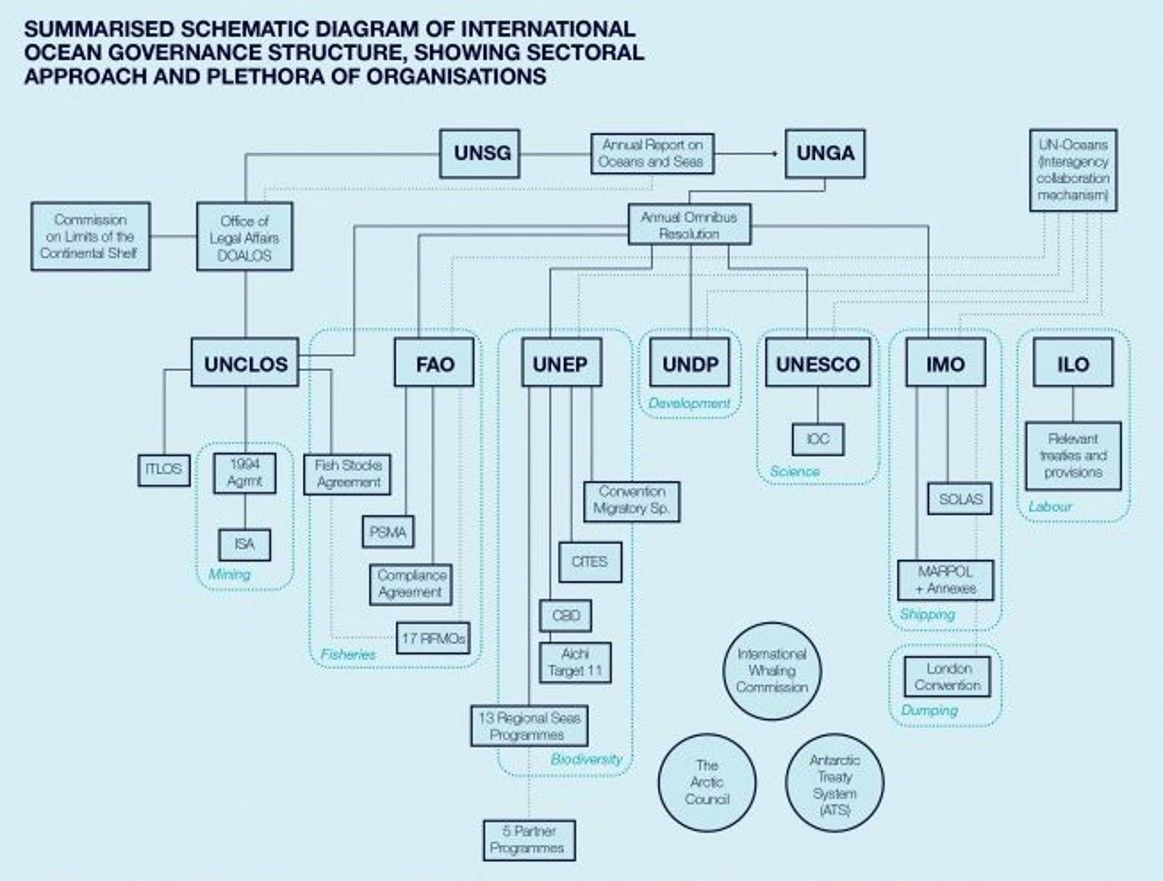
Our ocean provides a perfect example of the 'Tragedy of the Commons,' with multiple potentially catastrophic challenges from ineffectively regulated activities. These include ineffective regulation of fishing activities leading to the depletion of 80% of global fisheries7 , acidification of our ocean, collapse of coral reef ecosystems, rising sea levels8 , as well as human challenges such as piracy in vulnerable areas9 and increasing levels of land-based pollution which accounts for over 80% of all marine pollution (e.g., heavy metals, plastics, agricultural runoff, radioactive runoff).
This has led to a 'spaghetti soup' of overlapping governance arrangements, with similarly notable gaps (e.g., lack of governance of the High Seas, which comprise 45% of the world's surface and over 64% of the total world's ocean). Notwithstanding individual efforts in particular sectors, the overall functioning of the ocean governance system is ineffective and unsustainable, and will not lead to positive outcomes for the ocean.
There is also a challenge of multiple, well-intended short term initiatives which attempt to address particular aspects of this problem (e.g., corals, fisheries, Arctic, piracy), but ultimately leads to incremental change to the system as a whole, even if there has been spectacular individual successes (e.g., in saving whales from extinction).
Methodology to design the OAB
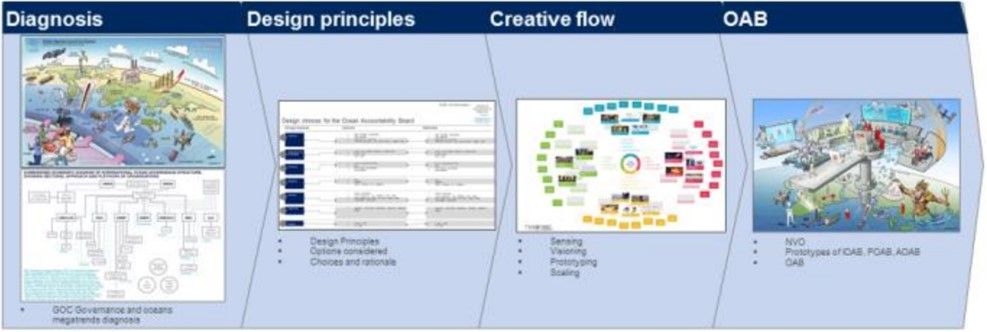
A four step process was followed to develop the final proposition to strengthen governance of the oceans. First, a deep diagnosis of current activities, megatrends are driving future uses of the ocean, and diagnosis of governance challenge facing the ocean was conducted by the Global Ocean Commission. Second, a series of Design Principles were agreed to ensure whichever solution is developed, should meet certain criteria (e.g., around legitimacy, financial sustainability, enforcement ability in a multi-dimensional world). Third, a creative flow process was applied to develop innovative solutions to these design principles. Finally a pathway to rapidly prototype and scale up an approach of the Ocean Accountability Board is being proposed, potentially being incubated through the Fasttrack Institute.
The OAB and its main features
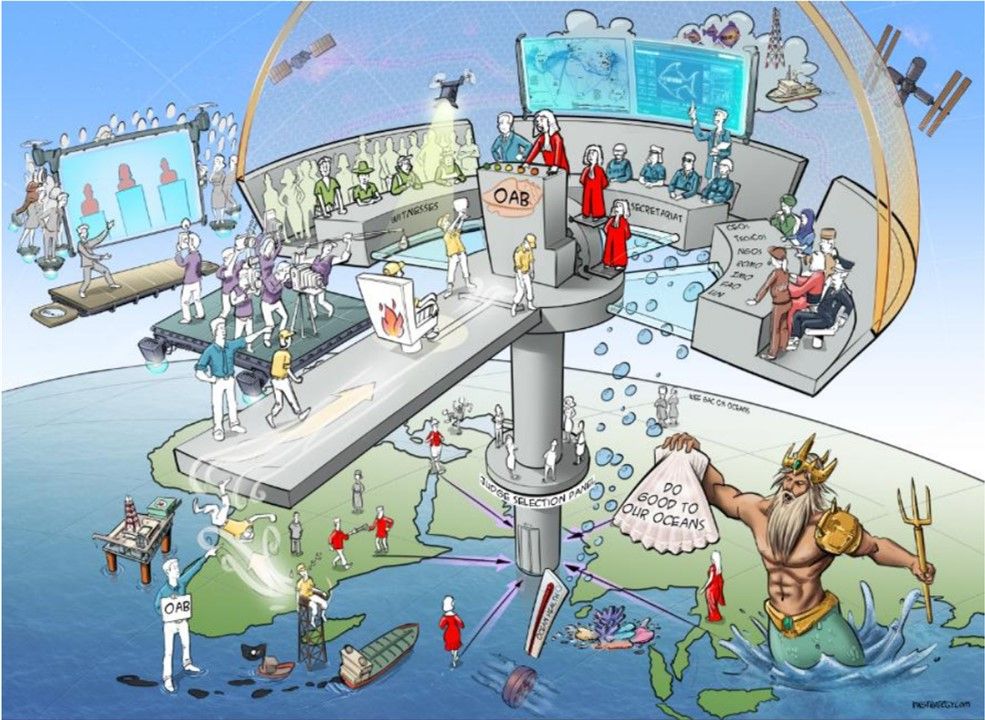
It is clear that no one single entity can address the challenges the ocean faces alone. Hence it is critical that the various stakeholders come together (from the UN system, Governments, business, local communities, NGOs, scientists and technologists). Similarly, any solution should take into account the radically changing world that we live in, and the new societal, environmental and technological changes we are seeing, in order to be sustainable over the long term.
The next section presents an overview of the Ocean Accountability Board, focusing on the Institutional Arrangements, Processes, and Tools needed for long term relevance. The graphic above illustrates some of the main features outlined in the text.
One of the most important features of the new OAB, is the ability to set the agenda on ocean matters, and the key role of those who can frame and set this agenda.
Institutional Arrangements
Several options were explored for the legal basis of an Ocean Accountability Board. Given the challenges ratifying various international and regional treaties, it was decided to create a body that has the ability to use moral suasion and innovative enforcement tools to ensure appropriate governance of the ocean, and also the nimbleness to adapt to particular needs.
In addition, given the growing importance of non-state actors and technology, their potential roles were also taken into account in the development of this new structure.
a) Board of Trustees
The principle organ of the OAB would be a Board of Trustees. This Board would comprise 40 or so of the world's most influential 'elder states-people' (e.g., Heads of State, global CEOs, Heads of International Organizations and NGOs), who wish to play a greater role on the global stage in improving the state of our ocean. These Trustees would be responsible for ensuring appropriate governance of the ocean.
b) Panel of Arbitrators
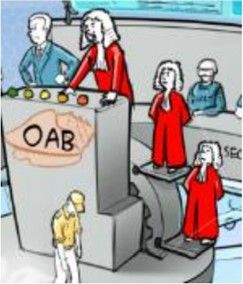
The main tool for the Trustees to intervene to rectify failures in ocean governance, would be through a panel of rotating Arbitrators, potentially drawn from the Board of Trustees. The Trustees will have a process to appoint them to the Ocean Accountability Board, and would be supported by a full time secretariat. The arbitrators would be appointed on a case by case basis (depending on the nature of the case) to summon and question actors suspected of harming the ocean through their actions.
c) Arbitrator Selection Panel

To ensure transparency, a Selection Panel would be created, which is a subset of the Ocean's Board of Trustees. Decisions of the Arbitrator Selection Panel would be published for the public to comment upon to ensure appropriate transparency.
d) Arbitrator toolkit
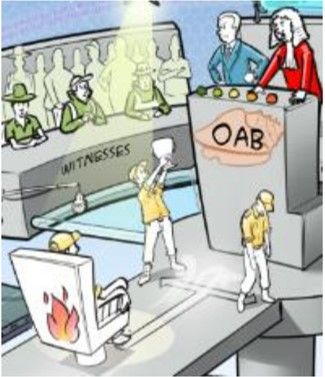
Given that the OAB will not have any formal legal standing, the question of how to exert influence over those whose behavior needs to change (e.g., fishing companies) was explored. A series of negative (punitive) and positive (celebratory) tools were explored. In terms of penalties, tools such as „name and shame,‟ „a blacklist,‟ „market pressures among major retailers,‟ and even „technological levers‟ could be utilized, which may be increasingly relevant over the next 20 years. This would all be subject to international law, and conducted in public. The influence of public opinion will count heavily. At the same time, the OAB will have the ability to celebrate success by having 'Annual Ocean Prizes,' as well as tools such as a League Table of ocean performance, star ratings for ocean users as well as an Annual Report on the 'State of the Ocean.'
e) Mandate for OAB Arbitrators
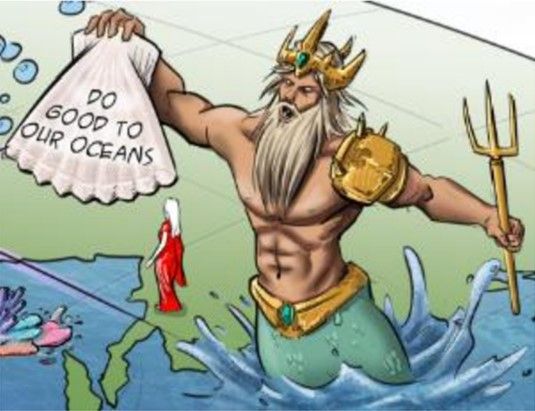
There were several options considered to guide judgements for the OAB Arbitrators, and hence the overall mandate of the OAB. A range of options were explored, from lengthy legal treaties to define the precise mandate (e.g., similar to an Ocean Bill of Rights, or several UN bodies), to more nimble guidelines (e.g., similar to the Financial Stability Board during the Eurozone Crisis) which could be suitably phrased to cater for any manner of incident on the ocean. In the same way, the operating mandates of large corporations were also explored by way of organizational benchmark (e.g., from global Natural Resource Companies with very detailed manuals governing ways of working and standard operating procedures, to global Technology and Retail Companies which have a more nimble set of principles to guide operations). This more nimble approach was felt to be more appropriate for the OAB. Given this, a second level of discussion on whether the mandate should be negative (e.g., 'Do No Harm to Our Oceans') or positive (e.g., 'Do Good to Our Oceans'). Whilst 'Do Not Harm' reflects an appropriate benchmark for intervention, it is challenging to raise the aspiration level. Whereas „Do Good to Our Oceans‟ enabled arbitrators to gauge more than whether an actor was „doing harm,‟ to the ocean but also celebrate the success of progressive companies and governments that are doing substantially more good to our ocean than other organizations.
Hence the mandate of the OAB Arbitrators is proposed to be “Do Good to Our Ocean.”
It should be clear that the OAB should not replace existing legal instruments (e.g., UNCLOS) and a code of conduct should be agreed regarding addressing sovereignty issues and summoning heads of state to appear before the OAB.
f) The Process
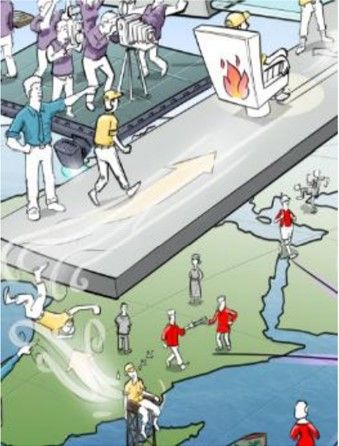
As described, the OAB will not have long laws or guidance. It will just have one mandate to guide arbitrators. The OAB will use its power of moral suasion to influence either CEOs, Ministers, or heads of international organizations to appear before it. The process will be kept flexible and will be determined through discussions with the Head of the Secretariat. This ensures the organization can remain flexible and address new challenges in innovative ways, rather than be caught up in procedures.
g) Capabilities and the OAB Secretariat
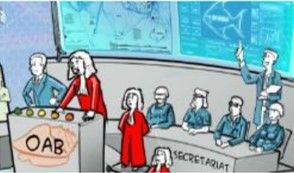
The key role in the Secretariat will be the Head of Secretariat. This individual will be very senior and be seen as a peer to Ministers and CEOs, with a strong track record of leading transformational change. This is a major departure from many existing international organizations which traditionally have a strong state-dominated board, and a weaker Secretariat. With the OAB, it is important to also have an influential Secretariat. One innovation would be to explore whether compensation of the Secretariat and its head could be linked to performance (for example, linking compensation to healthy ocean outcomes).
The Head of the Secretariat will not have the ability to vote on the judgments by the arbitrators, but will be able to guide the arbitrators on the tools available to them.
The role of the Secretariat is to identify priority topics, seek input from experts, independently analyze data, engage with the public and civil society, and ultimately call upon individual organizations to appear before the Ocean Accountability Board Judges.
The Secretariat supports the Board of Trustees with an Annual Report on the „State of the Ocean,‟ e.g., presented at Davos each year. The OAB meetings could be structured as 12 meetings a year, for 1 full day each (like a Monetary Policy Committee meeting).
It is important to ensure the meetings have the relevance and excitement of a format that engages the public to hold offenders to account, ensure appropriate behavior change (e.g., consumer pressure against particular ocean using companies), and hence clear communication of the evidence on ocean related topics.
This requires particular operational capabilities which the OAB will need, particularly in having Thought Leaders around Leadership, Performance Management, Operational Capabilities, Stakeholder Management, Data analysis.
g) Ocean Data and Evidence
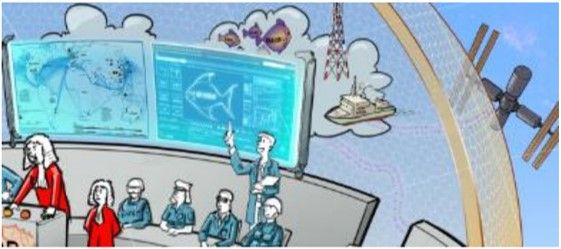
An open source system of data input will be sent to the OAB, and compiled from various sources (e.g., satellites, ocean sensors, shipping companies, NGO activists, the public). Innovative new Big Data techniques and Data Visualizations will help provide a more accurate assessment of performance of organizations and identify actionable areas for them to execute on following feedback from the OAB.
h) Importance of Public Engagement

Public Opinion and scrutiny is important in governance, given the new multidimensional world the international system is moving towards. This is particularly important for the OAB process to be effective, given that the OAB does not have formal legal tools (e.g., via a UN agreed process). Hence it is critical that the arbitrators consider the impact of the discussions under open public scrutiny, and similarly, the heads of the organizations called up to appear in front of the media (whether it is today's media, or thinking ahead in terms of the impact that social media may one day have on organizations).
In addition to public opinion of those accused of harming the ocean, or those who are being celebrated for positive impact on the ocean, it is also important to consider the incentives for arbitrators. Given the impact in popular media where there is often a greater citizen participation in popular televised talent contests than watching very bureaucratic committees, the OAB could employ an innovative measure of outsourcing the coverage of the event to external agencies. These agencies would be responsible for increasing coverage of the Judges, including a public vote for the most popular judge. To ensure innovation, the agencies would be paid based on the overall aggregate voter turnout they are able to secure (which will be independently audited). This is then an additional lever to ensure the appropriate quality of arbitrators and sufficient public understanding and scrutiny of the arbitration process.
Organizational sustainability and long term relevance
i) Innovative Financing of the OAB
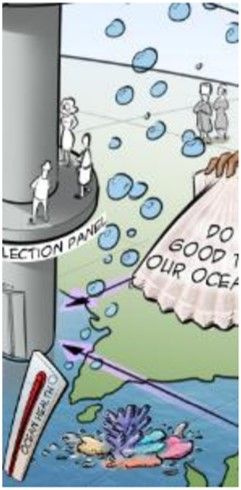
It is crucial to ensure that whichever design of the OAB is implemented, it is also financially and organizationally sustainable for many decades. Several options were considered for funding the OAB. Traditional models would imply funding as a grant from either an international body (e.g., UN, World Bank) states (e.g., DFID, USAID), Foundations (e.g., Rockefeller). Another model would be to find a means to tax ocean activities to fund the operations of the organization. Such a move would be challenging given the lack of legal levers to enforce such payments. An innovative third way could be to incentivize the organization by incubating „healthy ocean activities.‟ For example, via the IFC or Long Term Institutional Investors (e.g., University Endowments, Pension Funds, Insurance Firms, Sovereign Wealth Funds), an innovative Venture Capital structure could be set up to invest in long term health activities (e.g., investing in a publicly available genetic library of marine species, or funding sustainable medicinal uses of marine species). A fee from the Investment Committee of such a structure would go to funding the Secretariat.
Hence one option is to reframe the regulator as a self-funding Social Enterprise.
j) Fit for Purpose review

To ensure organizational sustainability, there could be a periodic 'Fit for Purpose' review (e.g., every 3 years) that would be jointly led by leading international organizations.
Conclusion: 'Business as Usual' is not sustainable
It is clear that our current activities on the ocean are not sustainable and will lead to catastrophic losses to communities around the world unless radical action is taken.
The concept of an OAB was developed to suggest an innovative governance approach that is not just applicable today, but can work under a degree of uncertainty given future technological and political changes, and is also sustainable long term, with closely aligned incentives to improving the outcomes of the ocean.
Nothing short of a modern-day 'Ocean Magna Carta' is needed to radically transform the state of our ocean. Perhaps the Ocean Accountability Board could pave the way for such a charter and the new paradigm of leadership required for our ocean and all other commons.
Next steps for the OAB
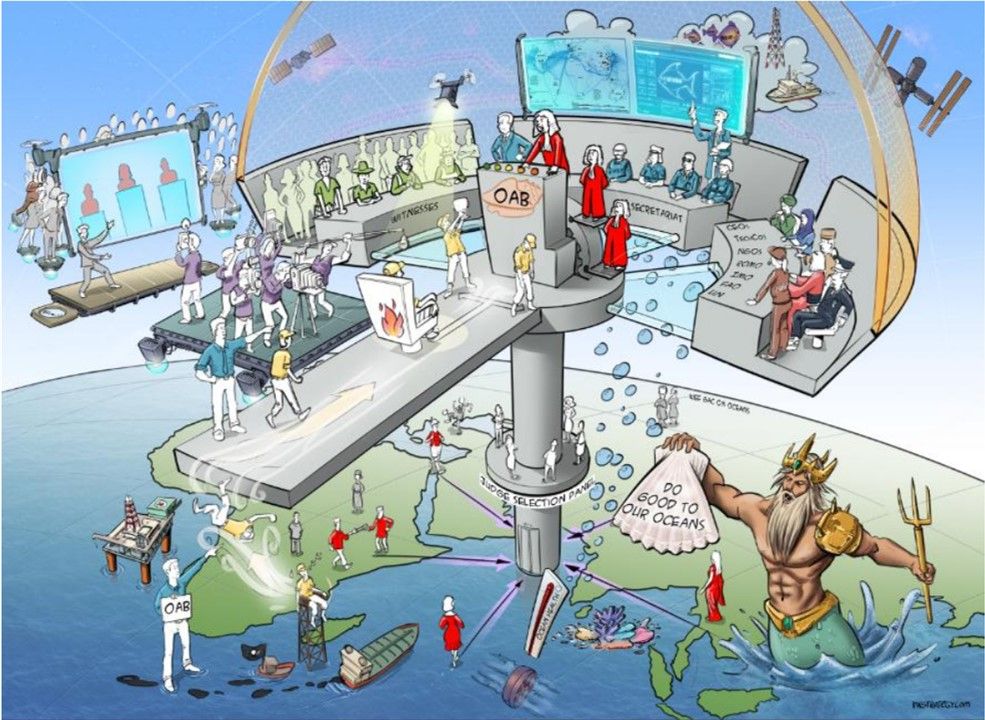
Both a bottom-up and top-down approach is needed to realize the vision of the OAB. The OAB could be incubated under a two year initiative and involving a coalition of the willing of forward-thinking stakeholders, as well as local grassroots community organizations strongly entrenched among coastal communities. There is a need to prototype the Ocean Accountability Board, and pilots could be run in ocean basin areas, such as the Indian Ocean, Pacific Ocean and Atlantic Ocean, convening around an annual calendar of regional events.
ExO Insight Newsletter
Join the newsletter to receive the latest updates in your inbox.








